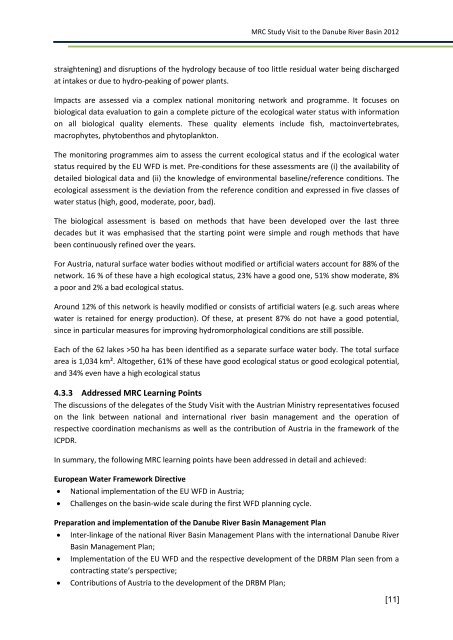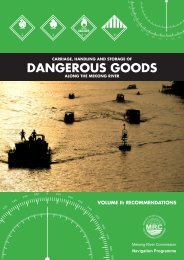evaluation of the study visit - Mekong River Commission
evaluation of the study visit - Mekong River Commission
evaluation of the study visit - Mekong River Commission
Create successful ePaper yourself
Turn your PDF publications into a flip-book with our unique Google optimized e-Paper software.
MRC Study Visit to <strong>the</strong> Danube <strong>River</strong> Basin 2012<br />
straightening) and disruptions <strong>of</strong> <strong>the</strong> hydrology because <strong>of</strong> too little residual water being discharged<br />
at intakes or due to hydro-peaking <strong>of</strong> power plants.<br />
Impacts are assessed via a complex national monitoring network and programme. It focuses on<br />
biological data <strong>evaluation</strong> to gain a complete picture <strong>of</strong> <strong>the</strong> ecological water status with information<br />
on all biological quality elements. These quality elements include fish, mactoinvertebrates,<br />
macrophytes, phytobenthos and phytoplankton.<br />
The monitoring programmes aim to assess <strong>the</strong> current ecological status and if <strong>the</strong> ecological water<br />
status required by <strong>the</strong> EU WFD is met. Pre-conditions for <strong>the</strong>se assessments are (i) <strong>the</strong> availability <strong>of</strong><br />
detailed biological data and (ii) <strong>the</strong> knowledge <strong>of</strong> environmental baseline/reference conditions. The<br />
ecological assessment is <strong>the</strong> deviation from <strong>the</strong> reference condition and expressed in five classes <strong>of</strong><br />
water status (high, good, moderate, poor, bad).<br />
The biological assessment is based on methods that have been developed over <strong>the</strong> last three<br />
decades but it was emphasised that <strong>the</strong> starting point were simple and rough methods that have<br />
been continuously refined over <strong>the</strong> years.<br />
For Austria, natural surface water bodies without modified or artificial waters account for 88% <strong>of</strong> <strong>the</strong><br />
network. 16 % <strong>of</strong> <strong>the</strong>se have a high ecological status, 23% have a good one, 51% show moderate, 8%<br />
a poor and 2% a bad ecological status.<br />
Around 12% <strong>of</strong> this network is heavily modified or consists <strong>of</strong> artificial waters (e.g. such areas where<br />
water is retained for energy production). Of <strong>the</strong>se, at present 87% do not have a good potential,<br />
since in particular measures for improving hydromorphological conditions are still possible.<br />
Each <strong>of</strong> <strong>the</strong> 62 lakes >50 ha has been identified as a separate surface water body. The total surface<br />
area is 1,034 km². Altoge<strong>the</strong>r, 61% <strong>of</strong> <strong>the</strong>se have good ecological status or good ecological potential,<br />
and 34% even have a high ecological status<br />
4.3.3 Addressed MRC Learning Points<br />
The discussions <strong>of</strong> <strong>the</strong> delegates <strong>of</strong> <strong>the</strong> Study Visit with <strong>the</strong> Austrian Ministry representatives focused<br />
on <strong>the</strong> link between national and international river basin management and <strong>the</strong> operation <strong>of</strong><br />
respective coordination mechanisms as well as <strong>the</strong> contribution <strong>of</strong> Austria in <strong>the</strong> framework <strong>of</strong> <strong>the</strong><br />
ICPDR.<br />
In summary, <strong>the</strong> following MRC learning points have been addressed in detail and achieved:<br />
European Water Framework Directive<br />
� National implementation <strong>of</strong> <strong>the</strong> EU WFD in Austria;<br />
� Challenges on <strong>the</strong> basin-wide scale during <strong>the</strong> first WFD planning cycle.<br />
Preparation and implementation <strong>of</strong> <strong>the</strong> Danube <strong>River</strong> Basin Management Plan<br />
� Inter-linkage <strong>of</strong> <strong>the</strong> national <strong>River</strong> Basin Management Plans with <strong>the</strong> international Danube <strong>River</strong><br />
Basin Management Plan;<br />
� Implementation <strong>of</strong> <strong>the</strong> EU WFD and <strong>the</strong> respective development <strong>of</strong> <strong>the</strong> DRBM Plan seen from a<br />
contracting state’s perspective;<br />
� Contributions <strong>of</strong> Austria to <strong>the</strong> development <strong>of</strong> <strong>the</strong> DRBM Plan;<br />
[11]













